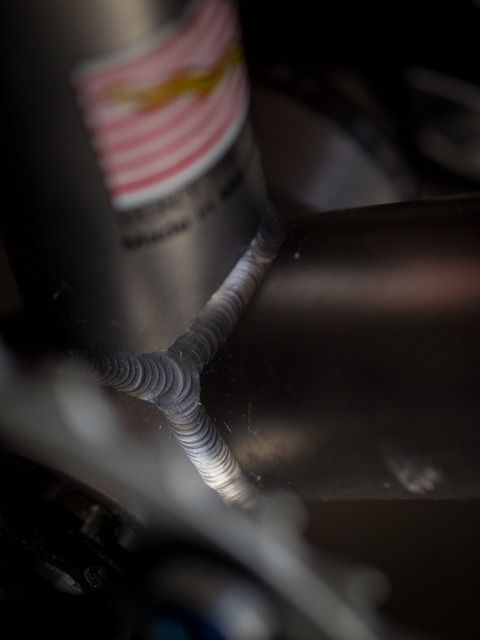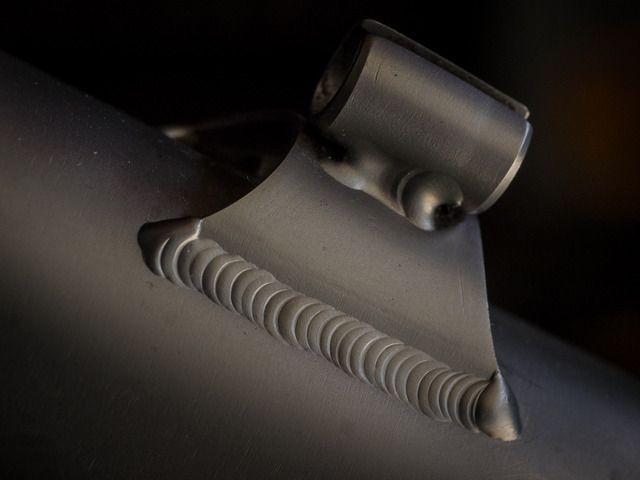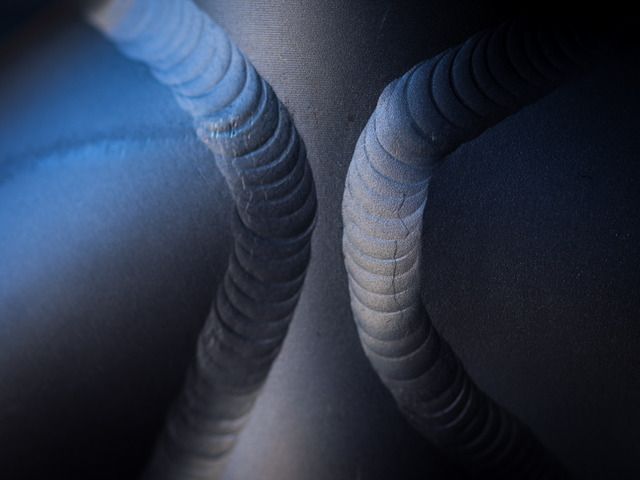You are using an out of date browser. It may not display this or other websites correctly.
You should upgrade or use an alternative browser.
You should upgrade or use an alternative browser.
94 Fat Chance Ti Garage Find
- Thread starter sriracha
- Start date
I photograph jewelry for some of my clients and the problem with high-end Olympus lenses is they are so incredibly sharp that you start to see things the client does not want shown. At first I thought these were cracks, and my heart sunk. But now I'm thinking it's something that happens to Titanium when you weld it.
These photos were taken on both sides of the seatpost showing the Top Tube and Seat Pose welds.
Scott, have you seen this before? It almost looks like scales on top of the welds:


Please tell me this is natural.
These photos were taken on both sides of the seatpost showing the Top Tube and Seat Pose welds.
Scott, have you seen this before? It almost looks like scales on top of the welds:


Please tell me this is natural.
Last edited:
Stingercut
Active member
Duplicate
Duplicate.
Duplicate.
Stingercut
Active member
I will have to go and inspect mine more closely. I have ridden mine hard a few times and im no light weight. No question I would have noticed if these were cracks and it would have failed. I worked in warranty years ago and tested so many different types of cracked frames.
What kind of camera set up and resolution are you taking such sharp pictures with btw ? They look amazing. Wish i could get close to that detail.
What kind of camera set up and resolution are you taking such sharp pictures with btw ? They look amazing. Wish i could get close to that detail.
What kind of camera set up and resolution are you taking such sharp pictures with btw ? They look amazing. Wish i could get close to that detail.
I shoot with an Olympus OMD-EM1 micro-4/3 16mp camera. The first two batches are shot with a Leica 42.5mm f1.2 lens. The close up shots are with a 50mm f2 Olympus Zuiko macro lens. Both lenses are really sharp wide open and have smooth out-of-focus transitions. The macro lens has a very close focus distance, which allows details greater than what I can see with my bare eyes. I have a variety of other lenses, all fixed focal lengths, sharp and bright.
Let me know what you see on your frame.
Stingercut
Active member
I shoot with an Olympus OMD-EM1 micro-4/3 16mp camera. The first two batches are shot with a Leica 42.5mm f1.2 lens. The close up shots are with a 50mm f2 Olympus Zuiko macro lens. Both lenses are really sharp wide open and have smooth out-of-focus transitions. The macro lens has a very close focus distance, which allows details greater than what I can see with my bare eyes. I have a variety of other lenses, all fixed focal lengths, sharp and bright.
Let me know what you see on your frame.
I guess my Iphone with Olloclip Macro lens won't cut it then :beer: Will get back to you about the welds on mine. Intriguing that its only on some welds, not others, maybe Scott can chime in
I searched around on the internet and found a couple forum threads discussing this same thing on the welds of Kent Eriksen and Moots titanium frames, along with pictures that looked very similar.
My biggest initial concern was that they were not cracks effecting the structural integrity. I'm perfectly fine if they are not cracks. In fact, I feel quite relieved. I'm going to go over it with a magnifying glass just to confirm. Hopefully it all looks good and then I can continue the build and ride this beautifully crafted machine!
:beer:
My biggest initial concern was that they were not cracks effecting the structural integrity. I'm perfectly fine if they are not cracks. In fact, I feel quite relieved. I'm going to go over it with a magnifying glass just to confirm. Hopefully it all looks good and then I can continue the build and ride this beautifully crafted machine!
:beer:
I-ROBOT
Active member
To calm everyone's fears:
NO they are not cracks, just minor surface irregularities. Typically they are the result of minute oxidation reactions on the hot surface since it is virtually impossible to shield the weld zone completely just using a conventional TIG torch. I built a trailing shield that attached to the torch for welding the downtube gussets which helped with shielding that large area but you still get some straw and a even a little blue coloring on the welds. That is why all of the TI frames were glass-bead blasted and have that satiny finish. The only way to avoid any oxidation is to weld the part inside of what is known as a "dry box". The air in the dry box is sucked out by a vacuum pump down to negligible levels (which also removes all moisture - hence the term dry box) and then the box is back-filled with pure argon so all traces of reactive gases and moisture are gone and then you leave the part in the box until it is cooled below the reactive temperature (I think for TI that is about 400F)
One of the coolest things about TI welding is that when you complete the weld, the surface is a virtual mirror and you can see yourself in the reflection. As much as I would have liked to leave the mirror-finish welds, we would always have a little discoloration which would spoil the look, so they were bead blasted. You could polish the welds if you chose to and those surface irregularities would disappear.
There was one guy who worked at Merlin for a while who polished his entire frame and it was absolutely blinding out in the sun. Think it took him about a month to do it.
If it makes you feel better, you could perform a liquid penetrant examination of the welds and you would find that the irregularities do not extend more that a few millionths deep and do not hold enough penetrant to reveal any rejectable indications.
Hope this helps
Scott
NO they are not cracks, just minor surface irregularities. Typically they are the result of minute oxidation reactions on the hot surface since it is virtually impossible to shield the weld zone completely just using a conventional TIG torch. I built a trailing shield that attached to the torch for welding the downtube gussets which helped with shielding that large area but you still get some straw and a even a little blue coloring on the welds. That is why all of the TI frames were glass-bead blasted and have that satiny finish. The only way to avoid any oxidation is to weld the part inside of what is known as a "dry box". The air in the dry box is sucked out by a vacuum pump down to negligible levels (which also removes all moisture - hence the term dry box) and then the box is back-filled with pure argon so all traces of reactive gases and moisture are gone and then you leave the part in the box until it is cooled below the reactive temperature (I think for TI that is about 400F)
One of the coolest things about TI welding is that when you complete the weld, the surface is a virtual mirror and you can see yourself in the reflection. As much as I would have liked to leave the mirror-finish welds, we would always have a little discoloration which would spoil the look, so they were bead blasted. You could polish the welds if you chose to and those surface irregularities would disappear.
There was one guy who worked at Merlin for a while who polished his entire frame and it was absolutely blinding out in the sun. Think it took him about a month to do it.
If it makes you feel better, you could perform a liquid penetrant examination of the welds and you would find that the irregularities do not extend more that a few millionths deep and do not hold enough penetrant to reveal any rejectable indications.
Hope this helps
Scott
Thanks for the reply, Scott! That is reassuring to hear. Is this a case of what they call, Alpha Case?
There's a local old school guy where I live, called Titanium Tim, who has an all titanium mountain bike. He makes titanium v-brakes that are mirror polished, like you describe...pretty!
Titanium Tim told me that a Fat Chance Titanium is a Top-5 of all-time frame.
Was it a rather uncomfortable work situation to weld titanium? I would think on a hot day it was rough!
There's a local old school guy where I live, called Titanium Tim, who has an all titanium mountain bike. He makes titanium v-brakes that are mirror polished, like you describe...pretty!
Titanium Tim told me that a Fat Chance Titanium is a Top-5 of all-time frame.
Was it a rather uncomfortable work situation to weld titanium? I would think on a hot day it was rough!
I-ROBOT
Active member
If you want to read some master's level research, I found this thesis written by Stephanie Douglas as part of her masters degree study at nearby MIT. One of the phenomena described is "basket-weave solidification" which is what I think we are seeing on some of the welds on your frame.
Welds are subject to relatively high levels of shrinkage stress due to the fact that one type of molten metal is being poured (literally) into two pieces of solid metal creating a bond between the two pieces of solid metal which are basically at room temperature. Welding creates large grains in the metal structure which can be affected by solidification stress. This stress can cause grain boundaries to open up resulting in cracks if the stress is high enough to propagate through many grain boundaries. Most surface fissures are small enough that the solidification stress is not enough to make them open enough to be considered defective. Over time, fatigue may cause these to open up and propagate as well as impact loads that may be encountered from jumping, crashing or other events that the designer could not plan for. Since bicycle frames are built to be as light as possible, the safety factor in design is always pushed to the limit.
There are too many variables in the welding process to discuss here and many of them would be over most reader's heads (including mine!)
If anyone wants to read the thesis, here is the link:
http://www.dtic.mil/dtic/tr/fulltext/u2/a255371.pdf
Oh well back to work
Scott
Welds are subject to relatively high levels of shrinkage stress due to the fact that one type of molten metal is being poured (literally) into two pieces of solid metal creating a bond between the two pieces of solid metal which are basically at room temperature. Welding creates large grains in the metal structure which can be affected by solidification stress. This stress can cause grain boundaries to open up resulting in cracks if the stress is high enough to propagate through many grain boundaries. Most surface fissures are small enough that the solidification stress is not enough to make them open enough to be considered defective. Over time, fatigue may cause these to open up and propagate as well as impact loads that may be encountered from jumping, crashing or other events that the designer could not plan for. Since bicycle frames are built to be as light as possible, the safety factor in design is always pushed to the limit.
There are too many variables in the welding process to discuss here and many of them would be over most reader's heads (including mine!)
If anyone wants to read the thesis, here is the link:
http://www.dtic.mil/dtic/tr/fulltext/u2/a255371.pdf
Oh well back to work
Scott
I-ROBOT
Active member
It's crazy how much prep, equipment and technique you had to invent to build these frames, Scott. I feel like you were a pioneer in titanium bikes.
I don't really feel like I was any sort of pioneer. Gary Helrich and Chris were the real TI pioneers. Gary wanted to go all titanium and Chris still wanted to work with steel so Gary left and founded Merlin (originally Kestrel - wish I had one of those shirts) Metalworks.
I came along after Gary but Chris didn't get back into TI until we moved out of Olive Square and into Linden Street. The Olive Square shop was so old and dirty that it never would have supported TI frame manufacturing on any scale.
I had a couple of good engineering guys that helped me create a lot of the weld tooling that was need to successfully weld TI and that really made the difference. Also being away from Merlin helped as well. (I think they had moved to Watertown even before we moved out of Olive Square)
Chris also tried to keep his design unique since Merlin had been in the market for a while as well as Litespeed and Dean which were probably their biggest competitors in the TI market. I believe Litespeed eventually bought out Merlin? is that correct? I know there are still a handful of others that produce TI frames now (Seven, Firefly on the east coast that I know of).
Scott
Stingercut
Active member
Thanks for the reply, Scott! That is reassuring to hear. Is this a case of what they call, Alpha Case?
There's a local old school guy where I live, called Titanium Tim, who has an all titanium mountain bike. He makes titanium v-brakes that are mirror polished, like you describe...pretty!
Titanium Tim told me that a Fat Chance Titanium is a Top-5 of all-time frame.
Was it a rather uncomfortable work situation to weld titanium? I would think on a hot day it was rough!
Good to hear they are top 5 of Tim's all time greats but some of need to know which ones make up the other 4.
I-ROBOT
Active member
Thanks for the reply, Scott! That is reassuring to hear. Is this a case of what they call, Alpha Case?
There's a local old school guy where I live, called Titanium Tim, who has an all titanium mountain bike. He makes titanium v-brakes that are mirror polished, like you describe...pretty!
Titanium Tim told me that a Fat Chance Titanium is a Top-5 of all-time frame.
Was it a rather uncomfortable work situation to weld titanium? I would think on a hot day it was rough!
I wouldn't say welding titanium was uncomfortable any more than welding any other type of metal. I will never complain about the heat since any welder that complains about the heat is in the wrong business!! LOL Besides, it gives me every right to complain about the cold - especially since we have one more snowstorm about to roll in here tonight
Here is a good article from Welding Tips and Tricks regarding titanium. It's written in layman's terms so all of you should be able to understand it rather than me having to type it out. It seems to be accurate as far as I can tell.
http://www.weldingtipsandtricks.com/welding-titanium.html
To me, titanium was beautiful to weld. I do miss that since we don't work with it here at Confab. There was a learning curve to be sure but once I got there, wow.
It did help that I already had some experience welding reactive metals since I was working in a tantalum factory in Newton when the opportunity at Fat City came along. They had a couple of dry boxes and lots of other special tools for preparing and welding tantalum and niobium (formerly columbium). I used to run a semi-automatic seam welder that created tubing from flat sheet. In 1986, 1" diameter 0.015" wall (28 Ga sheet equivalent or 0.37 mm) tantalum tube sold for $200 per foot (approx $650 USD per meter). It is used to line heat exchangers in chemical plants that produce acids. It is impervious to corrosion from sulfuric acid.
Since the average wall thickness of TI tube used in bike frames is 0.035" (0.9 mm), it seemed pretty thick compared to razor-thin TA sheet.
We also had fun making other things from scrap titanium (cough cough wheeze hack)
I still have some at home
Scott
We also had fun making other things from scrap titanium (cough cough wheeze hack)
I still have some at home
Scott
cough cough! awesome! that would be cool to have some Fat Chance titanium pieces! cough cough!
:skull:
I read the titanium welding guide...the easier one. Interesting stuff! Thanks for sharing the geek knowledge.
uno-speedo
Member
Titanium Tims bike is amazing.
Thanks for sharing your knowledge, Scott. And great photos sriracha.
Thanks for sharing your knowledge, Scott. And great photos sriracha.
chefmiguel
New member
Fantastic find, good thing it was you who found it and not someone equally as disinterested in it as the original owner.







